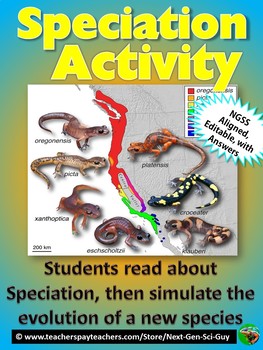Speciation Activity: Simulate Evolution of New Species: NGSS: Distance Learning
- Zip
What educators are saying
Description
In brief, students begin by generating questions based upon experimental results (Powerpoint Slide included). Then, they read about several types of speciation. Then, students simulate speciation within a hypothetical population of frogs, using manipulatives to create a model. Finally, students answer post-activity questions.
A. NEXT GENERATION SCIENCE STANDARDS HEREIN
DCI’s: LS3.B: Variation of traits
LS4: Biological Evolution: Unity and Diversity
Cross Cutting Concepts: Patterns, Cause and Effect, Scale, Proportion and Quantity, Systems and Models, Stability and Change
Scientific and Engineering Practices:
Asking Questions and Defining Problems
Analyzing and Interpreting Data
Constructing Explanations and Designing Solutions
Developing and Using Models
B. SUGGESTED USES
Prior Knowledge: Students should have a foundational understanding of evolution by natural selection.
"Evolution Unit Bundle" includes everything you need to teach a unit on Evolution, and its NGSS aligned.
Get it here: Evolution Unit Bundle
"Evidence for Evolution: Stations Lab" explores six lines of evidence that support evolution by natural selection. Each line of evidence is its own station, and students use inquiry to complete the lab.
Get it here: Evidence for Evolution Stations Lab
"Hacking Cladograms" is a student-centered activity that walks students through how to interpret, and create a cladogram.
Get it here: Hacking Cladograms
"Adaptations Project" involves researching a specific organism's adaptations, and constructing a physical model of an adaptation. It is NGSS aligned.
Get it here: Adaptations Project
"Antibiotic Resistance Lab" models the evolution of antibiotic-resistant bacteria. Students then simulate the evolution of a “superbug” infection
Get it here: Antibiotic Resistance Lab
"Thinking Like Darwin" is a a good intro activity when teaching evolution, requiring students to make connections, and draw generalizations, about organisms that live in three different locations in the world.
Get it here: Thinking Like Darwin
"Adaptations Project" involves researching a specific organism's adaptations, and constructing a physical model of an adaptation. It is NGSS aligned.
Get it here: Adaptations Project
Implementing the Lesson:
Materials and Setup: Dice, coloring utensils, glue, scissors, and this packet.
I suggest the teacher begins the lesson with the “Do Now Speciation Intro Slide” that comes with the download. The slide asks students to generate questions about an experiment that is described. The results of the experiment show that a fruit fly population, which is divided into two enclosures, and fed different food sources, preferred not to mate with the other population once it was reintroduced 35 generations later. The intro activity primes students’ brains to think about speciation, and encourages a discussion about how organisms change, and why they eventually become separate species.
This rest of the activity is designed for students to be able to read, and walk through, the packet without too much help from the teacher. However, I am sure you will have to give a brief overview, and facilitate as the students encounter new terms and concepts.
I’ve included answers, with suggest point values for each task. All materials are editable.
Terms of Use
• This packet is 1 classroom/teacher use only. Do not make copies or
email it to your colleagues. This was designed by me and is for your
personal (one user)use. You may
not share it or claim it as your own. You may not redistribute it.
If colleagues are interested in it, please send them the link to my store:
https://www.teacherspayteachers.com/Store/Next-Gen-Sci-Guy
• You are not permitted to use any part of this work to
create products for sharing or selling.
• You are permitted to share the cover image of the packet
on your website when referring to it in a post, as long as
you link back to my store.
All rights reserved by author.



